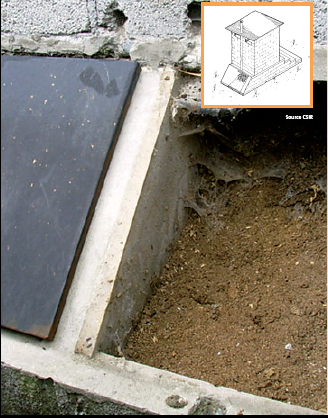Difference between revisions of "Dehydration"
From Akvopedia
Lagerstrom (talk | contribs) (creation of content) |
|||
| (One intermediate revision by one other user not shown) | |||
| Line 1: | Line 1: | ||
| − | [[Image:Dehydration_icon. | + | [[Image:Dehydration_icon.jpg|right]] |
In double vault dehydration systems, as described in the collection section `collection' on vaults-chambers, excreta may dry inside the vault as a result of sun radiation, natural evaporation and ventilation. Absorbents such as lime, ash or dry soil should be added to the chamber after each defecation in order to absorb moisture, making the pile less compact. The product from a dehydration process is a kind of mulch, rich in humus, carbon, fibrous material, phosphorous and potassium. It should be stored, sun-dried or composted in order to kill off all pathogens. | In double vault dehydration systems, as described in the collection section `collection' on vaults-chambers, excreta may dry inside the vault as a result of sun radiation, natural evaporation and ventilation. Absorbents such as lime, ash or dry soil should be added to the chamber after each defecation in order to absorb moisture, making the pile less compact. The product from a dehydration process is a kind of mulch, rich in humus, carbon, fibrous material, phosphorous and potassium. It should be stored, sun-dried or composted in order to kill off all pathogens. | ||
| Line 30: | Line 30: | ||
<li>User commitment to operate and maintain the system is essential.</li> | <li>User commitment to operate and maintain the system is essential.</li> | ||
</ul> | </ul> | ||
| + | |||
| + | {{Joinus}} | ||
== External links == | == External links == | ||
* General information about Dehydration [http://www.gtz.de/ecosan www.gtz.de/ecosan ] | * General information about Dehydration [http://www.gtz.de/ecosan www.gtz.de/ecosan ] | ||
* General information [http://www.csir.co.za www.csir.co.za ] | * General information [http://www.csir.co.za www.csir.co.za ] | ||
Latest revision as of 20:43, 22 December 2008
In double vault dehydration systems, as described in the collection section `collection' on vaults-chambers, excreta may dry inside the vault as a result of sun radiation, natural evaporation and ventilation. Absorbents such as lime, ash or dry soil should be added to the chamber after each defecation in order to absorb moisture, making the pile less compact. The product from a dehydration process is a kind of mulch, rich in humus, carbon, fibrous material, phosphorous and potassium. It should be stored, sun-dried or composted in order to kill off all pathogens.
| Advantages | Disadvantages |
|---|---|
| Efficient pre-treatment of excreta. Maximum reduction of excreta volume. |
Poor maintenance can quickly lead to malfunctioning. Anal cleaning water should be kept separate. |
Costs
- Investment costs complete double vault system, freestanding unit US$ 160 (1998 Mexico).
- Investment costs complete double vault system, in house unit US$ 35 (2002 China).
- Operation and maintenance costs - Very low (no transportation included).
Applying conditions
- Dehydration toilets are suitable in most climatic conditions, but function best in arid climates, with high average temperatures, long dry periods and short rainy seasons.
- Dehydration systems are most useful in rural and peri-urban areas, using the mulch onsite. Urban and large scale application has to be supported by collection systems. (See Cartage system).
- Dehydration of excreta is favoured by diverting urine and anal cleaning water. Dehydrating mixed excreta only works properly in very dry climates.
- User commitment to operate and maintain the system is essential.

Click here to see how you can contribute pictures
|
External links
- General information about Dehydration www.gtz.de/ecosan
- General information www.csir.co.za

